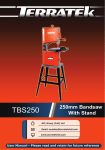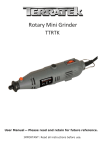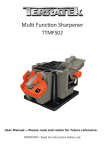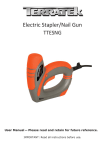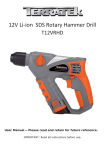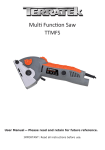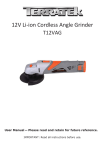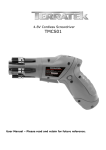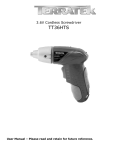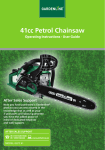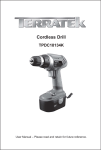Download TTID750 - User Manual
Transcript
Electric Hammer Dril TTID750 User Manual — Please read and retain for future reference. IMPORTANT: Read all instructions before use. Contents Parts List Technical Information Safety Instructions Using your drill Maintenance Warranty Parts List 1 Exploded Assembly Diagram NOTICE: Actual product may vary from pictures shown. 2 2 3 1 4 7 6 5 8 Fig.1 1. Drill chuck 2. Drill depth stop 3. Drill/hammer drill selector switch 4. Locking button 5. ON/OFF switch 6. Speed controller 7. Forward/Reverse switch 8. Additional handle 3 Fig.2 Fig.3 Technical Information Model: TTID750 Power input: 750 W Idling speed: 0-2,900 /min Drilling capacity Concrete: Ø 13 mm Steel: Ø 10 mm Wood: Ø 16 mm Protection class: II Weight: 2.2 kg Sound and vibration Sound and vibration values were measured in accordance with EN 60745. LPA sound pressure level 90 dB(A) KPAuncertainty 3 dB LWA sound power level 1 04 dB(A) KWAuncertainty 3 dB Read this entire manual before using this product. Failure to do so can result in serious injury. Save this manual for future reference. Copyright© 2013 by ACL Group (Intl) Ltd. All rights reserved. This manual or any artwork contained herein must not be reproduced in any shape or form without the express written consent of ACL Group (Intl) Ltd. Diagrams within this manual may not be drawn proportionally. Due to continuing improvements, actual product may differ slightly from the product described herein. 4 Read and Keep This Manual Please read carefully all instructions within this manual. Failure to follow all safety warnings can result in serious personal injury. The term “Power Tool” in all of the following warnings refers to your mains operated (corded) or battery operated (cordless) power tool. Important SAFETY Information This symbol is to warn you of potential personal injury hazards. Please read carefully the notes along side this warning to avoid possible injury or death. General Safety Rules WARNING! Read all instructions. Failure to follow all instructions listed below may result in electric shock, fire and/or serious injury. The term “power tool” in all of the warnings listed refers to corded or cordless power tools. Work area safety Keep work area clean and well lit. Cluttered or dark areas invite accidents. Do not operate power tools in explosive atmospheres, such as in the presence of flammable liquids, gases or dust. Power tools create sparks which may ignite the dust or fumes. Keep children and bystanders away while operating a power tool. Distractions can cause you to lose control. 5 Electrical safety Before use, ensure that the power outlet you are using matches the plug on your power tool and that the voltage of the outlet matches that of your power tool. Only use grounded extension cords with power tools fitted with 3 pin plugs and if using outdoors ensure any extension cord is suitable for outdoor use. Always try to avoid body contact with grounded surfaces, such as radiators, cooking ranges and any other fixed appliance with metal surfaces. Do not expose your power tool to wet or damp conditions and NEVER use in rain. Check regularly the power cord of your machine and any extension cord that you are using for damage. Do not carry or pull the machine with the power cord. Ensure the cord is clear from hot surfaces, oil or sharp objects. Personal safety Never use your power tool whilst under the influence of alcohol, drugs or medication. Tiredness can often cause accidents, stay alert. Never use your power tool without the correct guards in place. Always use approved eye protection and dust mask. Non slip safety shoes and hearing protectors should be worn at all times when using your power tool. Ensure any dust collecting device supplied with your machine is connected correctly before use. Ensure all loose clothing, long hair or jewelry is kept clear of the machine. Before plugging your power tool into the power outlet ensure the power tool is in the OFF position. Check that wrenches or adjusting keys have been removed. Any wrench or key left attached to a moving part can result in injury. Power tool use and care. Keep your power tool clean and well serviced at all times. Never adjust or service any power tool before disconnecting from the mains electricity supply. Always use the correct tool for the job. Never force the tool to work harder than it is designed to do. Never use your power tool with broken parts such as switches, guide fences or leg stands. ALWAYS keep your power tools away from children. Keep cutting tools sharp to ensure less stress on the motor. Only have your power tool serviced by a qualified repair agent using manufacturers recommended parts. 6 Service Have your power tool serviced by a qualified repair person using only identical replacement parts. This will ensure that the safety of the power tool is maintained. Develop a periodic maintenance schedule for your tool. When cleaning a tool be careful not to disassemble any portion of the tool since internal wires may be misplaced or pinched or safety guard return springs may be improperly mounted. Certain cleaning agents such as gasoline, carbon tetrachloride, ammonia, etc. may damage plastic parts. When servicing a tool, use only identical replacement parts. Follow instructions in the Maintenance section of this manual. Use of unauthorized parts or failure to follow Maintenance Instructions may create a risk of electric shock or injury. WARNING: For your own safety read Instruction Manual before operating your power tool. A) Wear eye protection. B) Keep hands out of the path of cutting tools. C) Do not operate tool without guards in place. D) Do not perform any operation freehand. E) Never reach around cutting tools. F) Turn off tool and wait for cutting tools to stop before moving work piece or changing settings. G) Disconnect power (or unplug tool) before changing cutting tools or servicing. GENERAL SAFETY INSTRUCTIONS Read this owner's manual completely and make sure you understand all of its safety guidelines. 1. KEEP GUARDS IN PLACE and in working order. 2. REMOVE ADJUSTING KEYS & WRENCHES. Before turning on the power tool, make sure the keys and adjusting wrenches have been removed. 3. KEEP WORK AREA CLEAN. Cluttered areas and benches invite accidents. 4. ALWAYS REMAIN ALERT WHEN THE TOOL IS IN USE. Inattention on the part of the operator may lead to serious injury. 5. DON’T USE IN A DANGEROUS ENVIRONMENT. Don’t use power tools in damp or wet locations or expose them to rain. Keep work area well lit. 6. KEEP CHILDREN AWAY. All visitors should remain at a safe distance from work area. 7. MAKE WORKSHOP CHILD-PROOF with padlocks, master switches or by removing starter keys. 8. USE THE RIGHT TOOL. Don’t force a tool or attachment to do a job for which it was not designed. 7 9. USE THE PROPER EXTENSION CORD. Make sure your extension cord is in good condition. When using an extension cord, be sure to use one heavy enough to carry the current your product will draw. An undersized cord will cause a drop in line voltage resulting in loss of power and overheating. If in doubt, use the next heavier gauge. The smaller the gauge number, the heavier the cord. 10. DON’T FORCE THE TOOL. It has been designed to operate at maximum safety and performance levels. 11. DO NOT FORCE THE MATERIAL BEING CUT. Always let the tool cut at its own speed. 12. WEAR PROPER APPAREL. Do not wear loose clothing, neckties, rings, bracelets or other jewelry which may get caught in moving parts. Non-slip foot wear is recommended. Wear protective hair covering if you have long hair. 13. ALWAYS USE SAFETY GLASSES. Also use face or dust mask for commercial cutting operations. Everyday eyeglasses only have impact-resistant lenses, they are NOT safety glasses. 14. SECURE WORK. Use clamps or a vise instead of your hand to hold work when practical. This safetyprecaution allows for proper tool operation using both hands. 15. DON’T OVERREACH. Keep proper footing and balance at all times. 16. MAINTAIN TOOLS WITH CARE. Keep tools clean and in good working condition for maximum safety performance. Follow instructions for lubricating and changing accessories. 17. DISCONNECT TOOLS BEFORE SERVICING – when changing accessories, such as blades, bits, cutters, etc. 18. REDUCE THE RISK OF UNINTENTIONAL STARTING. Make sure switch is in OFF position before plugging in. 19. USE RECOMMENDED ACCESSORIES. Consult the owner’s manual for recommended accessories. The use of improper accessories may increase risk of injury. 20. MAKE SURE YOU USE THE CORRECT TOOL for the job you are doing. 21. NEVER STAND ON TOOL. Serious injury could occur if the tool is tipped or if the cutting tool is unintentionally contacted. 22. CHECK DAMAGED PARTS. Before further use of the tool, damaged part(s), (i.e., guard) should be carefully checked to determine that it will operate properly and perform its intended function. Check for alignment of moving parts, binding of moving parts, breakage of parts, mounting and any other condition that may affect the tools operation. A guard or other part that is damaged should be properly repaired or replaced. 23. Replace damaged blades/cutters immediately. DO NOT USE DAMAGED BLADES/CUTTERS. They may cause bodily injury. 24. DIRECTION OF FEED. Feed work into the blade/cutter against the direction of rotation of the blade/cutter only. 25. DO NOT ALTER THE PLUG. 8 26. NEVER LEAVE TOOL RUNNING UNATTENDED. Turn power off. Don’t leave tool until it comes to a complete stop. 27. Double Insulation eliminates the need for the three wire grounded power cord and grounded power supply system. This power tool is supplied with all the relevant safety guards and features, it should be checked before every operation, this manual should be read and kept in a safe place. Whilst we warn of all the possible risks attached to using power tools any operator must have read and understood the manual and apply their own caution and common sense when using this power tool. Following this guide will greatly reduce your risk of electric shock or injury. Only use qualified repair agents to service this power tool. Only use qualified electrician to repair any damaged wiring. NEVER remove the grounding prong from the power tool or extension cord. 9 Symbols IMPORTANT: Some of the following symbols may be used on your tool. V…………………………volts A…………………………amperes Hz……………………….hertz ~…………………….….alternating current …/m……………….....revolutions per minute .....................class II construction (double insulated) Kg………………………..kilograms n0………………………..No load speed ……………….….....Conforms to European Harmonised New Approach Directives. DC ………………..…….Direct Current Important! The vibration value changes according to the area of application of the electric tool and may exceed the specified value in exceptional circumstances. Specific Safety Rules 1) Hold power tools by insulated gripping surfaces when performing an operation where the cutting tool may contact hidden wiring. Contact with a “live” wire will make exposed metal parts of the tool “live” and shock the operator. 2) Wear ear and eye protection. To avoid hearing loss and eye injuries. 3) If the bit becomes jammed, immediately turn the trigger switch off to prevent an overload which can damage the motor. Use reverse to loosen jammed bits. 4) Do NOT operate the Forward/Reverse lever when the trigger switch is on. Damage to the unit may occur. 5) When storing or carrying the tool, set the Forward/Reverse lever to the center position (switch lock). 6) Do not strain the tool by holding the speed control trigger halfway so that the motor stops. 7) Be careful not to get dust inside the chuck. 8) Do not touch the rotating parts to avoid injury. 9) Do not use the tool continuously for a long period of time. Stop using the tool from time to time to avoid overheating of the motor. 10) Do not drop the tool. 10 Unpacking Carefully remove the product and any accessories from the box. Make sure that all items listed in the packing list are included. Package contents A) Drill B) User manual Functional Description (Fig.1) WARNING: Disconnect the plug from the power source before making any assembly, adjustments or changing accessories. Such preventive safety measures reduce the risk of starting the tool accidentally. Operation The drill is designed for drilling holes into wood, iron, non-ferrous metals and concrete using the appropriate bits. The equipment is to be used only for its prescribed purpose. Any other use is deemed to be a case of misuse. The user / operator and not the manufacturer will be liable for any damage or injuries of any kind caused as a result of this. Please note that our equipment has not been designed for use in commercial, trade or industrial applications. Our warranty will be voided if the machine is used in commercial, trade or industrial businesses or for equivalent purposes. Installing the additional handle (Fig.1-8) Installing the additional handle (Fig.1-8) The additional handle (8) enables you to achieve better stability whilst using the hammer drill. Do not use the tool without the additional handle. The additional handle (8) is secured to the hammer drill by a clamp. Turning the handle clockwise tightens this clamp. Turning it counter-clockwise will loosen the clamp. The supplied additional handle (8) must first be installed. To do this, the clamp must be opened by turning the handle until it is wide enough for the additional handle to slide over the chuck (1) and on to the hammer drill. After you have positioned the additional handle (8), turn it to the most comfortable working position for you. Now turn the handle in the opposite direction again until the additional handle is secure. The additional handle (8) is suitable for both left-handed and right-handed users. 11 Installing and adjusting the depth stop (Fig.1-2) The depth stop (2) is held in place by the additional handle (8) by clamping. The clamp can be released and tightened by turning the handle. Release the clamp and fit the depth stop (2) in the recess provided for it in the additional handle. Set the depth stop (2) to the same level as the drill bit. Pull the depth stop back by the required drilling depth. Turn the handle on the additional handle (8) until it is secure. Now drill the hole until the depth stop (2) touches the workpiece. Installing the drill bit (Fig. 1) Always pull the power plug before making adjustments to the equipment. Release the depth stop (2) as described in above and push it towards the drill handle. This provides free access to the chuck (1). Undo the chuck by turning it counter-clockwise . To ensure that it is perfectly positioned the drill bit or tool should be inserted as far as possible into the chuck. After inserting the drill bit or tool, tighten the chuck (1) until the drill bit or tool is secure. Check that the drill bit is secure in the chuck (1). Check at regular intervals that the drill bit or tool is secure (pull the mains plug). On-Off Switch Variable speed controlled trigger switch Your tool is equipped with a variable speed trigger switch (Fig.1-5). The tool speed can be controlled from the minimum to the maximum nameplate RPM by the pressure you apply to the trigger. Apply more pressure to increase the speed and release pressure to decrease speed. Adjusting the speed (Fig.2-5) You can infinitely vary the speed whilst using the tool. Select the speed by applying a greater or lesser pressure to the ON/OFF switch (5). Select the correct speed: The most suitable speed depends on the workpiece, the type of use and the drill bit used. Low pressure on the ON/OFF switch (5): Lower speed (suitable for: small screws and soft materials) Greater pressure on the ON/OFF switch (5): Higher speed (suitable for large/long screws and hard materials and drilling) 12 Tip: Start drilling holes at low speed. Then increase the speed in stages. Benefits: The drill bit is easier to control when starting the hole and will not slide away. Forward/Reversing lever Your tool is equipped with a forward/ reversing lever (Fig. 2-7) located above the trigger. This lever is for changing rotation of the chuck. Drilling Place the bit on the work surface and apply firm pressure before starting. Too much pressure will slow the bit and reduce drilling efficiency. Too little pressure will cause the bit to slide over the work area and dull the point of the bit. If the tool begins to stall, reduce pressure slightly to allow the bit to regain speed. If the bit binds, reverse the motor to free the bit from the work piece. Preselecting the speed (Fig.2-6) The speed setting ring (6) enables you to define the maximum speed. The ON/OFF switch (5) can only be pressed to the defined maximum speed setting. Set the speed using the setting ring (6) on the ON/OFF switch (5). Do not attempt to make this setting whilst the drill is in use. Clockwise/Counter-clockwise switch (Fig.2-7) Warning! Changing switch position only when the drill is stopped! Switch the direction of the hammer drill using the clockwise/counter-clockwise switch (7). Direction Switch position Clockwise (forwards and drill) R Counter-clockwise (reverse) L Drill / Hammer drill selector switch (Fig.3 A-B) Warning! Changing switch position only when the drill is stopped! Drill Drill / hammer drill selector switch (3) in the drill position. (Position A) Use for: Wood, metal, plastic. Hammer drill Drill / hammer drill selector switch (3) in the hammer drill position. (Position B) Use for: Concrete, rock, masonry 13 Tips for working with your hammer drill Drilling concrete and masonry Switch the Drill/Hammer drill selector switch (3) to position B (Hammer drill). Always use carbide drill bits and a high speed setting for drilling into masonry and concrete. Drilling steel Switch the drill / hammer drill selector switch (3) to position A (drill). Always use HSS drill bits (HSS = high speed steel) and a low speed setting for drilling steel. We recommend that you lubricate the hole with a suitable cutting fluid to prevent unnecessary drill bit wear. Inserting/Removing screws Switch the Drill/Hammer drill selector switch (3) to position A (drill). Use a low speed setting. Inserting/Removing screws Switch the Drill/Hammer drill selector switch (3) to position A (drill). Use a low speed setting. Starting holes If you wish to drill a deep hole in a hard material (such as steel), we recommend that you pre-drill the hole with a smaller drill bit. Drilling tiles To start the hole, switch the drill / hammer drill selector switch (3) to position A (drill). Switch the drill / hammer drill selector switch (3) to position B (hammer drill) as soon as the drill bit has passed through the tiles. NEVER place hands or other body parts near the drill bit or chuck during operation. Hold the drill by its handle only. 14 Maintenance Use only a dry, soft cloth for wiping the unit. Do not use a damp cloth, thinner, or other volatile solvents for cleaning. Accessories CAUTION: Use only accessories or attachments recommended for use with your Terratek tool specified in this manual. The use of any other accessories or attachments might present a risk of injury to persons. Only use accessory or attachment for its stated purpose. General Maintenance 1. Keep the air vents free from obstruction and clean regularly. 2. Check regularly for any dust particles entering the grills around the motor and the switch. Use a soft brush to remove any dust particles. Wear safety glasses to protect your eyes whilst cleaning. 3. Monitor the dust bag (if equipped) and empty when approximately half full. Always empty into an appropriate container. REMEMBER: dust can be hot and cause fire. 4. If the cutting tool has become dull, replace it. Dull cutters will cause increased tear-out and ragged edges on the cuts. 5. Lubricate all moving parts at regular intervals. 6. To clean the body of the power tool, only use a soft damp cloth. Do NOT immerse in water. A mild detergent can be used but NOT petrol or any alcohol based product. 7. Should the power cord become damaged only allow a fully qualified electrician to replace or repair. Disposal Power tools, accessories and packaging should be sorted for environmentally-friendly recycling. Only for EC countries: Do not dispose of power tools into household waste! According to the European Directive 2002/96/EC on waste electrical and electronic equipment and its incorporation into national right, products that are no longer suitable for use must beseparately collected and sent for recovery in an environmentally-friendly manner. Environmental Protection RECYCLING: WASTE ELECTRICAL PRODUCTS SHOULD NOT BE DISPOSED OF WITH HOUSEHOLD WASTE. PLEASE RECYCLE WHERE FACILITIES EXIST. CHECK WITH YOUR LOCAL AUTHORITY OR RETAILER FOR RECYCLING ADVICE. 15 Declaration of Conformity We ACL Group (Intl.) Ltd, England DN6 8LZ declare that the 750W Electric Hammer Drill has been manufactured according to our full quality assurance procedures. The declaration is to certify that it conforms to CE, EMC, LVD, MD and RoHS directives: EN55014-1: 2006 + A1 EN55014-2: 1997 + A1 + A2 EN61000-3-2: 2006 + A1 + A2 EN61000-3-3: 2008 All provisions of Annex 1 of Council Directive 2004/108/EC – EMC directive EN60745-1: 2009 + A11 EN60745-2-1: 2010 ZEK 01.2 – 08/ 12.08 All provisions of Annex 1 of Council Directive 2006/42/EC – Machinery Directive 2006/95/EC – Low Voltage Directive RoHs 2011/65/EU 2011/65/EU Mr. Alan Garnett, UK QA Manager 16 Please read the following carefully ACL Group (Intl) Ltd. and/or it’s distributor has provided the parts list and assembly diagram as a reference tool only. Neither ACL Group (Intl). Ltd. or its distributor makes any representation or warranty of any kind to the buyer that he or she is qualified to do any repairs or replace any parts of this product. ACL Group (Intl) Ltd. and its distributor expressly state that all repairs or parts replacement should be done by certified or licensed technicians. The buyer assumes all risk and liability arising out of his or her repairs or parts replacement to the original product. 12 Months Limited Warranty If within 12 months from the date of purchase you experience any problems with your product, please return the product to its distributor/dealer for repair or replacement. This warranty DOES NOT COVER normal wear, or any damage as a result of accidents, misuse, abuse or negligence. ACL Group (Intl) Ltd Doncaster, England Email: [email protected] www.terratekintl.com 17


















